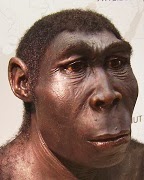 |
| 1.8 miljoonaa vuotta vanha lähes ehjä hominidin pääkallo kuva BBC ja Georgian National Museum |
Melissa Hogenboom, BBC News Science and Environment, kertoi 17.10. 2013:
The idea that there were several different human species walking the Earth two million years ago has been dealt a blow.
Instead, scientists say early human fossils found in Africa and Eurasia may have been part of the same species.
Writing in Science, the team says that Homo habilis, Homo rudolfensisand Homo erectus are all part of a single evolving lineage that led to modern humans.
But others in the field reject this.
A team looked at the most complete hominid skull ever found which was uncovered in Dmanisi, Georgia.
It had a small braincase, large teeth and a long face, characteristics it shares with H.habilis. But many features from the braincase were also unique to H.erectus.
The 1.8-million-year old skull comes from a site that has unveiled the biggest collections of well-preserved early human remains known anywhere in the world.
lue koko artikkeli BBC News: Science and Environment

Jotain uutta on taas ilmeisesti löytynyt, nyt Etelä-Afrikasta
VastaaPoistahttp://www.theguardian.com/science/2015/sep/10/new-species-of-ancient-human-discovered-claim-scientists
Todella mahtava löytö luolasta - herättää paljon varmasti uusia ajatuksia tutkijoiden keskuudessa
Poista